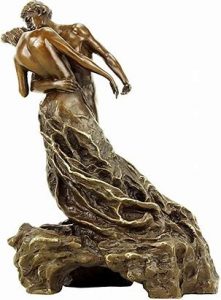The Waltz (La Valse) by Camille Claudel is a crucial work in her career, created between 1889 and 1905. This bronze sculpture beautifully captures human emotions and movement with remarkable detail. It portrays a couple engaged in a close, swirling dance, their bodies intertwined in a way that suggests intimacy and tension. The fluidity of their forms emphasizes their connection, while the subtle positioning of their bodies and closeness conveys a powerful sense of love and longing. 
At the time of its creation, The Waltz stirred controversy. When Claudel first submitted the work for purchase by the French government, it was rejected for being “too sensual.” The closeness of the figures, especially the woman’s flowing gown, which appeared to reveal too much, was deemed inappropriate. Claudel was forced to modify the sculpture, making the woman’s dress more modest before it could be exhibited. This incident highlights the difficulties she faced as a female artist, where her work was often scrutinized and overshadowed by the male-dominated art world and her relationship with Auguste Rodin.
The inspiration behind The Waltz is closely tied to Claudel’s complex relationship with Rodin, who was both her mentor and lover. Many see the sculpture as a reflection of their relationship’s ups and downs the passionate connection between the dancers mirrors the passion she shared with Rodin, while the tension in their embrace hints at the conflicts and difficulties within their love. The swirling movement of the figures conveys a sense of dizziness or instability, reflecting Claudel’s struggles with her mental health and her eventual separation from Rodin.
In my story, The Waltz serves as a symbol of Camille’s inner world—her passionate yet troubled relationship with Rodin. The sculpture reflects her desire for emotional closeness but also highlights the instability that defines their love. By focusing on the creation of The Waltz in my narrative, I can explore the emotional and mental toll this relationship took on Camille, using the sculpture as a metaphor for her unraveling.
The tension and discomfort I want to evoke in my story align perfectly with the themes of The Waltz. Its reception—celebrated for its beauty but criticized for its sensuality—mirrors Camille’s experience as an artist fighting for recognition. The sculpture represents more than just art; it’s an extension of Camille’s emotional world, her artistic voice, and the turmoil she faced in her relationship with Rodin. Including this historical context will add layers to my story, allowing the reader to better understand Camille’s inner conflict.